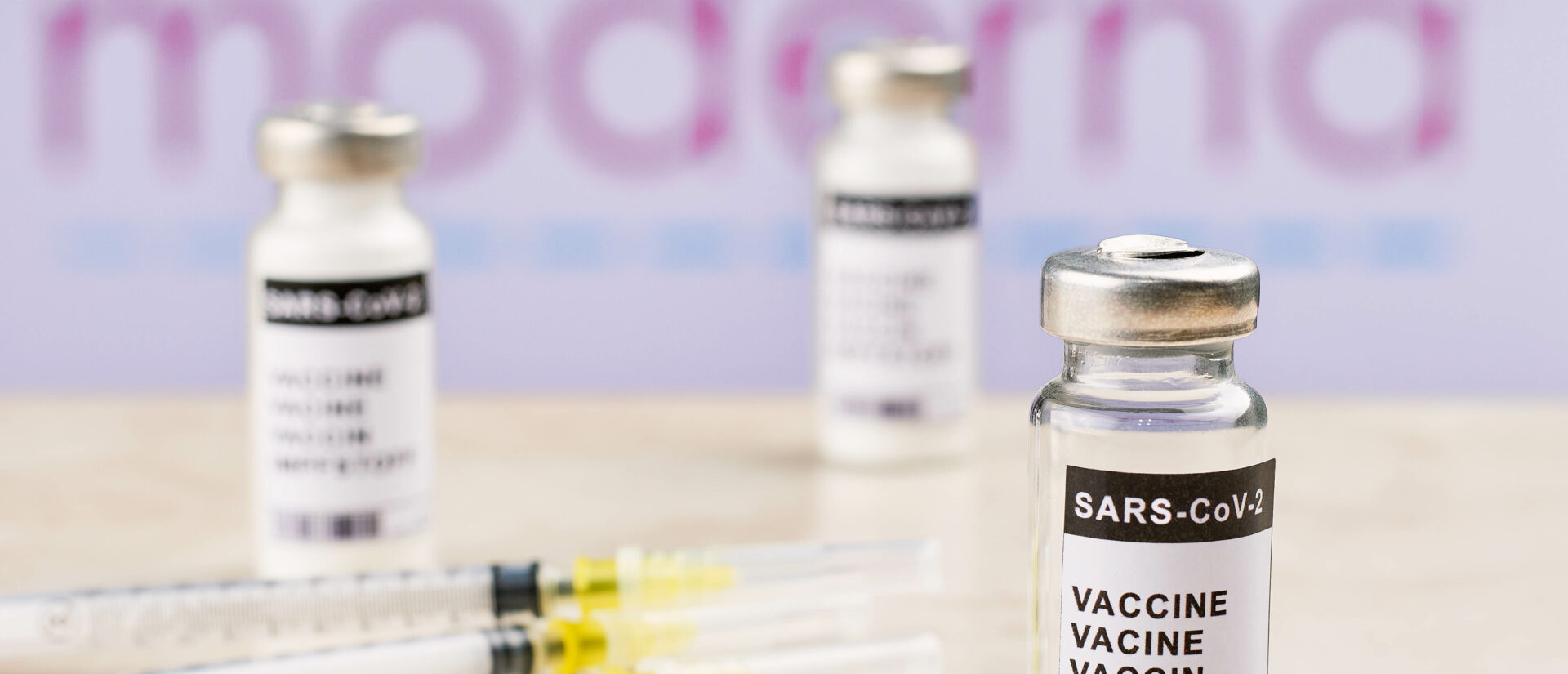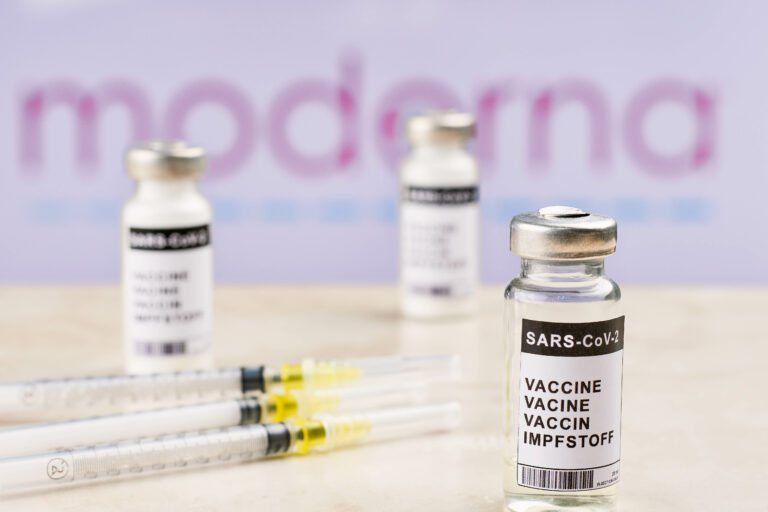
Moderna’s free ride
Pocketing tax free profits from publicly funded jabs
A leaked contract between Moderna and the European Commission indicates that the company’s vaccine profits will end up in some of the world’s worst tax havens. The contract signed with Moderna shows that it intends to receive payment for its EU vaccine deliveries in Basel, Switzerland. By accounting for its profits in this low-tax jurisdiction, Moderna is likely to pay little in taxes on the billions of euros it stands to make from the coronavirus crisis. Additionally, Moderna holds many of its patents in the US tax haven state of Delaware, where income from patents is exempt from taxation, providing the company with further opportunity to avoid taxes. This compounds existing economic justice issues plaguing the pharmaceutical industry, as the technology for these vaccines was developed using public finance, and the prices at which vaccines are sold to governments around the world allow pharmaceutical firms to make massive profits. This article was produced in cooperation with Wemos.
Moderna was set up in 2010 by researcher Derrick Rossi and three cofounders. Their intent was to continue Rossi’s research[1] into messenger ribonucleic acid (mRNA), which he had started at Harvard Medical School in 2007, to develop the technology into a marketable product.[2] In the years that followed, Moderna invested in developing the application of mRNA technology, which is now used in two of the world’s most potent coronavirus vaccines.[3]
Moderna’s coronavirus vaccine, dubbed “the people’s vaccine” by consumer group Public Citizen, has been developed with public funding, mainly from the US government.[4] According to Public Citizen, the development of the vaccine was entirely paid for by taxpayers.[5] Evidence for this claim is that both Moderna and BioNTech have used sublicences for their mRNA-related patents that stem from the University of Pennsylvania.[6] So the foundational technology they use was developed in a public institute with public funding. Besides this, a crucial patent needed to make the vaccine was developed by scientists at the US National Institutes of Health (NIH) and is owned by the US government.[7] In addition, the mRNA vaccine itself was jointly developed by Moderna and the US NIH, and consequently the patent for the Covid-19 vaccine is jointly owned by Moderna and the US government.[8] Moderna has not published how much it has spent on developing the vaccine and what percentage of its spending was covered by public funding. However, without the billions in funding Moderna received from the US government, the company would almost certainly have had a more difficult time developing its vaccine, because it would have needed to find investors to shoulder the risk taken on by the US government.
According to the US Department of Health and Human Services, by December 2020 Moderna had received US$4.1bn for vaccine development, clinical trials and manufacturing.[9] Approximately $1bn of this was granted by the Biomedical Advanced Research and Development Authority (BARDA), an agency that is part of the US Department of Health and Human Services.[10] The contract with BARDA reportedly contains a clause that requires Moderna to publish the proportion of its investment financed by the US government.[11] Moderna has failed to do so thus far.
There are no exact figures regarding how much of Moderna’s vaccine research and development (R&D) was financed through public subsidies. However, on its website Moderna lists an overview of the equity investments the company has received throughout its existence.[12] Coupled with any debt the company might have taken on to finance its R&D activities, these figures can provide some insight into the importance of subsidies for Moderna’s vaccine development. In total, Moderna lists approximately $1.5bn in direct equity investments by shareholders, and an additional $680m in investments through collaborations with other corporations.[13] Although Moderna’s list is not necessarily exhaustive, it seems likely that it accounts for most investments made into Moderna during its 11-year history. It is not clear what portion of these $2.2bn in investments made by shareholders and corporations was subsequently spent on R&D. What the figures do show, however, is that equity investments made in Moderna appear to have been overshadowed by the much larger public investments in the company during its existence, totalling at least $4.1bn.
A non-profit organisation, the Coalition for Epidemic Preparedness Innovations (CEPI), also provided a $900,000 grant to Moderna in January 2020 to develop its mRNA vaccine.[14] CEPI works under the COVID-19 Vaccines Global Access facility (COVAX), which includes the WHO, to provide coronavirus vaccines to all countries, regardless of their wealth. This early investment was reportedly crucial to get the vaccine’s development off the ground.[15] Moderna has agreed to CEPI’s “equitable access principles”, which state that vaccines should be distributed according to need and at affordable prices for at-risk populations, especially in low-and middle-income countries.[16] Despite accepting the grant with these conditions attached, Moderna has so far sold its vaccine primarily to the world’s wealthy countries and has failed to deliver any of its early production to CEPI.[17] Only in May 2021 did Moderna reach agreement with COVAX to deliver 34m doses in 2021, and 466m in 2022.[18] Several other vaccine producers preceded Moderna in coming to an agreement with COVAX,[19] and with only 34m doses promised for 2021, Moderna will continue to produce vaccines primarily for wealthy countries in the near future.
The research for this publication was done with the use of publicly available sources, including Moderna’s annual and quarterly accounts, media reports, corporate information database Refinitiv Eikon, and a leaked contract between Moderna and the European Commission. Two weeks before publication of this article, SOMO shared the findings presented here with Moderna for review, to allow the company to correct any factual inaccuracies. However, outside of an automatically generated message, Moderna failed to respond to SOMO’s review request and could not be contacted by phone, despite numerous attempts.
Moderna’s high prices
Moderna’s sole commercial product is its coronavirus vaccine,[20] known as mRNA-1273.[21] As such, 2021 is expected to become the company’s first profitable year, due to the massive vaccine sales it expects to make. Overall, Moderna estimates that sales for 2021 will be approximately $18.4bn.[22] Although the company does not specify exactly when each of its vaccine deliveries is likely to take place, it has already made agreements covering total sales of approximately 1.15bn vaccines over 2021-22.[23] The company does not provide a clear overview of the exact year in which these sales are expected to occur, but it seems probable that the majority of these sales – for which the contracts have already been negotiated – will take place in 2021. About 84% of these estimated sales will be going to the US and the EU, which have ordered 500m and 460m vaccine doses (including options) respectively.[24]
Information regarding the prices charged for coronavirus vaccines has been hard to come by. For its sales to the US government, Moderna will reportedly charge $15 per dose.[25] A contract between Moderna and the EU, known as an advance purchase agreement, which was leaked to the press earlier this year, shows that the European Commission and EU Member States have agreed to a total price of $22.50 per dose.[26] Prices Moderna has agreed with other governments have not been made public.
Assuming the prices charged to the US and the EU have stayed the same over the various contracts Moderna has signed with them, the company stands to generate sales of up to $7.5bn and $10.35bn respectively with these two trading partners.[27] Combined, the revenue solely from sales to the EU and US totals $17.85bn. As referenced above, Moderna itself has stated that it expects to generate $18.4bn in sales in 2021 alone.[28]
In a press release, Moderna reveals that it expects its cost of sales to be approximately 20% for 2021. Considering that its mRNA vaccine is currently its only commercial product, this probably means that for every dollar the company makes from the sale of a vaccine, $0.20 (20 cents) was spent on the vaccine’s production and marketing. Using this figure, independent analysts have reportedly concluded that the company’s profit for 2021 is likely to be around $8bn.[29] Other profit estimates go as high as $9.9bn,[30] but for the present analysis we will follow the more conservative estimation. Dividing Moderna’s expected profit by its turnover for 2021, this means that for every taxpayer dollar spent to buy a Moderna vaccine, the company will make a net profit of $0.44 (44 cents). Therefore, almost half of Moderna’s revenue will be profit, an exceptionally high margin.[31]
Beyond currently high profit margins, some pharmaceutical firms have already indicated that, once the pandemic ends, they intend to raise vaccine prices. In a recent call with investors, Pfizer CFO Frank D’Amelio stated that the current $19.50 price the company has charged the US government for its vaccine is the effect of lower “pandemic pricing”. Once the pandemic has ended and Covid-19 becomes endemic in societies across the globe, Pfizer’s CFO states the company’s intent is “to get more on price”.[32] To give a frame of reference for what prices the company hopes to charge then, D’Amelio references “normal” prices of $150 or $175 per dose, roughly 7.5 to 9 times as much as the company is currently charging the US and EU. And as the company produces more vaccine doses, D’Amelio indicates that he expects lower unit costs and therefore a “significant opportunity for … margins to improve”. The current profit margin Pfizer and its partner BioNTech make on each vaccine dose is in the 52%-58% range, based on the company’s own statements.[33] Judging by currently available information, post-pandemic pricing could increase that margin to between 1,500% and 2,000% if Pfizer’s plans work out, which would mean massive corporate profits paid for primarily with taxpayers’ money.[34]
Moderna executives appear to be thinking along similar lines to their counterparts at Pfizer, with Moderna CEO Stéphane Bancel stating in August 2020 that “we will be responsible on price well below [its] value during the pandemic”.[35] This statement implies that the $22.50 per Covid-19 vaccine dose Moderna has charged the European Commission and EU Member States is far below what the company believes the vaccine is actually worth. The fact that Moderna’s CEO explicitly commits the company to this below-value pricing during the pandemic implies that the company will aim to charge higher prices once the pandemic has ended. It is not clear what the basis is for Bancel’s assessment that Moderna’s vaccine is currently undervalued, especially considering the company’s already lucrative profit margin of approximately 44%.
Academic research published in 2020 reports that, from 2000 to 2018, the pharmaceutical industry’s profit margin was 13.8%, compared to other industries’ 7.7%.[36] Although relatively high, these margins are a far cry from Moderna’s expected 44% profit per vaccine. Representatives of the pharmaceutical industry have in the past argued that high prices are justified because of the high levels of R&D investments the industry makes, as well as the fact that many investments fail to turn into a marketable product.[37] In the case of Moderna’s Covid-19 vaccine, however, these R&D investments were publicly financed, decreasing the company’s risk. Additionally, the $18.4bn that Moderna expects to generate in 2021 stems from the advance purchase agreements the company has signed,[38] such as the leaked agreement signed with the European Commission. Such contracts arguably limit corporate risk even further, as vaccine providers like Moderna are guaranteed a market share and run less risk of losing out to faster and more efficient competitors. Taken together, these risk-limiting factors make Moderna’s expected high profit margin seem unjustified, and the company’s hints that it will raise prices post pandemic doubly so.
Limited information is available on the shareholders likely to benefit from Moderna’s expected profits. Although no exhaustive list of the company’s shareholders is publicly available, it is clear that many of the company’s largest shareholders are investment management companies, including Ballie Gifford (11.3% ownership), the Vanguard Group (4.7%) and BlackRock (4%).[39] Other notable shareholders are prominent academic Robert Langer (2.9%)[40] and Moderna’s CEO Stéphane Bancel (1.6%).[41]
Moderna’s tax haven presence
Moderna in Delaware
Moderna is a relatively new player in the pharmaceutical industry. It was incorporated in 2010 and has its headquarters in the US state of Massachusetts.[42] Although Moderna is effectively run from its headquarters in Massachusetts, legally speaking these headquarters are merely a branch of the corporation’s parent company,[43] located in the state of Delaware.[44] Besides its ultimate parent company, Moderna also controls ModernaTX Inc., another Delaware-based company. Delaware is a notorious global tax haven, known for the extremely low levels of taxation it offers corporations.[45] The state is home to 973,000 people[46] and approximately 1.5m companies.[47] Many of these companies are administered by corporate service providers and trust firms, and do not employ their own personnel. Moderna Inc.[48] and ModernaTX Inc.[49] both list corporate service provider The Corporation Trust Company as their agent. This company, also known known as CT Corporation, offers services like providing directors, producing annual reports, incorporating subsidiaries, or fulfilling due diligence and compliance requirements.[50] By taking over these functions, CT Corporation seems to facilitate corporations’ access to the legal benefits of being incorporated in Delaware without needing any real economic presence there.
Delaware is attractive for multinational corporations for various reasons. While companies registered there pay federal US taxes, Delaware provides resident companies with various fiscal advantages and exemptions[51] from its 8.7% corporate income tax rate.[52] Delaware-based companies are not taxed on the interest income they earn in the state.[53] The state’s business laws are “flexible”, and its court is “advantageous” for shareholders and “competent and experienced in tackling corporate issues”.[54] Importantly for Moderna, the state of Delaware also levies no tax on income generated through intangible assets, such as patents.[55] The pharmaceutical industry is one of the most patent-intensive industries in the world, and much of the profit generated by the sector comes from royalty payments for the use of these patents.[56] A company that registers its patents in Delaware pays no tax on this kind of income. Moderna is one such company.
A brief look at patent database PATENTSCOPE shows that Delaware-based ModernaTX Inc. holds approximately 780 patent registrations around the world.[57] Many of these patents will probably generate untaxed royalty income for Moderna in Delaware. The fact that Moderna’s intellectual property income accrues in the same jurisdiction as its ultimate parent company may not in itself be strange. Moderna could argue that its Delaware-based parent takes most of the financial risk within its various R&D processes, and it may directly compensate all subsidiaries for their R&D activities, allowing the company to argue that the remaining profits legitimately should end up in Delaware. Complex fiscal arguments aside, however, the result is likely to be a corporate group that is taxed at a very low rate overall.
Of the approximately 780 patents ModernaTX Inc. holds in Delaware, 595 patent registrations make mention of the mRNA technology that forms the basis for Moderna’s coronavirus vaccine.[58] In practice, if any of these patents are used by Moderna subsidiaries or third parties around the world, the respective organisation using the patented technology would have to compensate its owner, ModernaTX Inc. in Delaware. The resulting royalty payment then probably generates profits for Moderna in Delaware, but due to the state’s generous treatment of income from intangible assets, this profit is subject only to federal corporate income tax at a relatively low rate.[59] Moderna’s Q1 2021 report indicates that the company will make use of these tax benefits, stating that its effective tax rate was lower than the applicable statutory tax rate in part due to “the benefit of the foreign derived intangible income deduction”.[60] Within the frame of the Covid-19 crisis, this is likely to mean that part of the payment made by governments around the world for the delivery of vaccines will indirectly go to Delaware, as compensation for the use of mRNA patents held there. The profits shifted to Delaware this way will then probably be taxed at a relatively low rate.
Because Delaware is both a tax haven and a secrecy jurisdiction, annual accounts for ModernaTX Inc. are not publicly available.[61] This makes it impossible to determine the size of royalty payments that Moderna’s Delaware subsidiary has received and will receive from companies across the globe. The rate at which Moderna charges royalties to related companies for the use of its vaccine patent(s) will determine the extent of the company’s profits that end up in Delaware. The applicable transfer pricing rules based on OECD guidelines and imposed by the US and other governments provide much leeway, allowing companies to manipulate prices in order to create an outcome where they pay the least amount of tax. The fact that Moderna’s royalty income will go untaxed in Delaware creates an incentive to increase the size of these royalty flows as much as it can, while staying within the bounds of transfer pricing legislation. Assuming the company succeeds in this endeavour, the result will be profits generated around the world being shifted to Delaware, where they can go largely untaxed.
 Photo: Mariano Mantel CC2.0 via Flickr
Photo: Mariano Mantel CC2.0 via FlickrModerna in Switzerland
Since the start of 2021, the European Commission has signed two contracts with Moderna for the sale of coronavirus vaccines.[62] As previously discussed, the first of these contracts was leaked to the press.[63] What this contract reveals, on the first of its 69 pages, is that for the service of providing the EU with coronavirus vaccines, payment will be made to Moderna’s recently incorporated Swiss subsidiary, Moderna Switzerland GmbH.
Moderna Switzerland GmbH was incorporated in the canton of Basel in June 2020, when Moderna was in the middle of its vaccine clinical trials. On the 2021 Corporate Tax Haven Index published by the Tax Justice Network, Switzerland ranks as the world’s fifth most complicit jurisdiction in helping multinational corporations underpay corporate income tax.[64] According to its Swiss corporate registry filing, the company’s purpose is “to develop, import, market, manufacture and distribute drugs, vaccines and drugs based on messenger RNA”.[65] Like Delaware, the Swiss canton of Basel is a jurisdiction known for the low taxes it offers corporations.[66] In the past, Basel’s fiscal facilities allowed foreign corporations to set up holding companies with very limited commercial activities, which then enjoyed effective tax rates as low as 7.83%.[67] Recent tax reforms have altered Switzerland’s fiscal treatment of foreign corporations, but like other Swiss cantons, Basel has reportedly taken steps to maintain its attractiveness, including lowering its statutory tax rate from 20.7%[68] to 13%.[69]
Judging from the leaked contract with the European Commission, Moderna stands to earn its income for European vaccine sales in the tax haven jurisdiction of Basel. Any genuine economic basis for this structuring seems to be lacking, because Moderna Switzerland GmbH was created only in 2020 and does not appear to have been actively involved in vaccine development. The company also does not produce the vaccine, which Moderna has subcontracted in Europe to biotech firm Lonza. Lonza’s production takes place in the Swiss canton of Valais[70] and in the Netherlands,[71] but this does not provide a convincing economic rationale for why Moderna should earn its European vaccine income in Switzerland. Following tax justice logic, Moderna’s profits should accrue where its real economic activity to develop, produce and market its vaccines takes place. Each Moderna subsidiary that performs a function that contributes to the value of the marketable product – a Covid-19 vaccine in this case – should be compensated for its contributions. Subsidiary Moderna Switzerland GmbH, however, is only a year old and does not appear to perform many, if any, such functions.
Switzerland has been ranked the world’s third most secretive jurisdiction for financial regulation, and its laws demand very little transparency of companies.[72] Consequently Moderna Switzerland GmbH’s 2021 accounts will not become publicly available in coming years. It will likely be impossible for the public to determine the exact profits Moderna Switzerland GmbH will make, nor to see whether the company’s effective tax rate is even close to Basel’s low 13% statutory corporate income tax rate. There have been past cases of authorities in tax havens like Switzerland making preferential deals with multinational corporations, known as advance tax rulings, which have allowed companies to pay tax only on a portion of their total profits.[73] By applying the statutory corporate income tax rate only to a portion of profits – those considered attributable to the specific company – a much lower effective tax rate can be achieved. Considering the elaborate nature of Moderna’s incorporation in Switzerland, the company has probably agreed a tax ruling with the Swiss tax authorities. However, without access to Moderna Switzerland GmbH’s annual accounts for 2021 and the years to come, the company’s tax practice cannot be analysed, and we are left merely with strong indications that Moderna will funnel its vaccine profits into a Swiss tax avoidance structure.
As we know, Moderna Switzerland GmbH will be paid $22.50 per dose for an estimated maximum of 460m doses in 2021. This will result in a total of approximately $10.35bn in revenues accounted for in Switzerland. Of this $10.35bn, approximately 44% will likely be profit for the Moderna group,[74] but it is unclear what proportion of those profits will end up being taxed in Basel. The fact that Moderna is intent on receiving its Covid-19 vaccine revenues at this recently incorporated tax haven subsidiary, in a jurisdiction it did not have a significant economic presence in previously, indicates that this move was fiscally motivated. Moderna’s seemingly aggressive tax planning, as embodied by its presence in tax havens Delaware and Switzerland, suggests that the company may pay little tax on the profits it generates through European sales of its coronavirus vaccine.
Conclusion and recommendations
Public opinion of the pharmaceutical industry is said to have improved somewhat this year, probably due to the sector’s positive contribution in societies’ struggle with Covid-19.[75] Certainly, without the vaccines developed by various pharmaceutical firms, countries wealthy enough to access these vaccines would not currently be coming out of their year-long lockdowns. However, this article highlights some of the public concerns arising from the industry’s business model that get lost in this narrative. Key issues are that: (1) the development of Covid-19 vaccines was heavily subsidised by public funding; (2) current vaccine prices are relatively high compared to costs, and appear set to rise significantly, leading to massive profits for company shareholders paid for largely with public funds; and (3) the large profits that vaccine producer Moderna will make are likely to end up in tax havens Delaware and Switzerland. There is tangible economic injustice involved when taxpayers finance the development of a product, only to have it sold back to them at a hefty margin. The fact that resulting profits end up in tax havens, where they will almost certainly be taxed at a very low rate, if at all, compounds this injustice.
Recommendations
Tax avoidance:
- The European Commission and EU Member States should ensure that large payments for coronavirus vaccines are not made to subsidiaries based in tax havens where the contract partner does not have a commensurate economic presence. The EU and its Member States should ensure that public procurement policies are brought in line with their efforts to tackle tax avoidance.
- The European Commission and EU Member States should review their dealings with companies that make use of tax avoidance structures and consider how such companies can be made to cease their tax haven activities or risk being excluded from EU public procurement contracts.
High prices for Covid-19 vaccines:
- Covid-19 vaccine producers, including Moderna, should adjust the vaccine prices they charge to governments to reflect the economic reality that vaccine technology was developed using public finance, and to diminish the extremely high profit margins some producers currently enjoy at the cost of taxpayers.
Public procurement transparency:
- Governments around the world – and the EU and its Member States in particular – should publish public procurement contracts with a significant total value, such as Moderna’s $10.35bn contract, to increase transparency about the use of public goods, benefit market competition and improve governance.[76]
- Public institutes like CEPI, which purchase vaccines through advanced purchase agreements using public funding, should also provide full transparency about, and publish, their contracts.
Access to medicine:
- To effectively fight the pandemic, it is crucial to increase production capacity to boost global access to coronavirus vaccines, especially in low-income countries.
- Moderna should engage with the WHO COVID-19 Technology Access Pool (C-TAP) and the Medicines Patent Pool (MPP) and should publish the patents relevant to the technology, waive or license the patent rights, and provide technology transfer of the manufacturing know-how and data to enable other producers to manufacture the vaccine, especially in low-income countries.
- The US government should use its joint ownership of the vaccine patent to push Moderna to share its expertise with other manufacturers.
- All governments should attach conditions of affordability and accessibility to their public funding of vaccines and biomedical R&D.
Notes
[1] L Warren, et al., “Highly efficient reprogramming to pluripotency and directed differentiation of human cells with synthetic modified mRNA,” Cell Stem Cell 7, 5 (2010): 618-30, https://www.ncbi.nlm.nih.gov/pmc/articles/PMC3656821/(opens in new window) .
[2] D Garde and J Saltzman, “The story of mRNA: How a once-dismissed idea became a leading technology in the Covid vaccine race,” STAT special report, Nov. 2020, https://www.statnews.com/2020/11/10/the-story-of-mrna-how-a-once-dismissed-idea-became-a-leading-technology-in-the-covid-vaccine-race/(opens in new window) .
[3] These being the Moderna vaccine and that developed by BioNTech/Pfizer.
[4] Public Citizen, “Statement: Moderna Vaccine Belongs to the People,” Nov. 2020, https://www.citizen.org/news/statement-moderna-vaccine-belongs-to-the-people/(opens in new window) .
[5] @Public_Citizen, “Taxpayers paid for 100% of Moderna’s COVID-19 vaccine development,” Twitter, Nov. 2020, https://twitter.com/Public_Citizen/status/1328357640783634433(opens in new window) .
[6] M Gaviria and B Kilic, “A network analysis of COVID-19 mRNA vaccine patents,” Nat. Biotechnol. 39 (2021): 546-48, https://www.nature.com/articles/s41587-021-00912-9(opens in new window) .
[7] Financial Times, “Vaccine patent gives US ‘leverage’ over manufacturers,” Apr. 2021, https://www.ft.com/content/d0c70cc2-0ffa-42dd-b0d0-0f76eeb273f0(opens in new window) .
[8] M Gaviria and B Kilic, “A network analysis of COVID-19 mRNA vaccine patents,” Nat. Biotechnol. 39 (2021): 546-48, https://www.nature.com/articles/s41587-021-00912-9(opens in new window) .
[9] A Logue, “New Vaccine Deal Ups US Funding for Moderna to $4.1 Billion, Wisconsin Pharmacist Destroys 500+ Vaccine Doses,” Yahoo! Finance, Jan . 2021, https://yhoo.it/3yKwcfL(opens in new window) .
[10] Moderna Inc., “Moderna Announces Expansion of BARDA Agreement to Support Larger Phase 3 Program for Vaccine (mRNA-1273) Against COVID-19,” Jul. 2020, https://investors.modernatx.com/news-releases/news-release-details/moderna-announces-expansion-barda-agreement-support-larger-phase(opens in new window) .
[11] Knowledge Ecology International, “KEI on Moderna’s Oct 8, 2020 Statement on Intellectual Property Matters during the COVID-19 Pandemic,” Oct. 2020, https://www.keionline.org/34112(opens in new window) .
[12] Moderna Inc., “Key Milestones for Moderna,” https://www.modernatx.com/about-us/modernas-key-milestones-and-advancements(opens in new window) .
[13] Moderna Inc., “Key Milestones for Moderna,” https://www.modernatx.com/about-us/modernas-key-milestones-and-advancements(opens in new window) .
[14] Moderna Inc., (2020). “Moderna Announces Funding Award from CEPI to Accelerate Development of Messenger RNA (mRNA) Vaccine Against Novel Coronavirus,” Jan. 2020, https://investors.modernatx.com/news-releases/news-release-details/moderna-announces-funding-award-cepi-accelerate-development(opens in new window) .
[15] Gavi, “Gavi signs agreement with Moderna to secure doses on behalf of COVAX Facility,” May 2021, https://www.gavi.org/news/media-room/gavi-signs-agreement-moderna-secure-doses-behalf-covax-facility(opens in new window) .
[16] CEPI, “Enabling Equitable Access to COVID-19 Vaccines: Summary of equitable access provisions in CEPI’s COVID-19 vaccine development agreements,” Mar. 2021, https://cepi.net/wp-content/uploads/2020/12/Enabling-equitable-access-to-COVID19-vaccines-v4-18Mar2021.pdf(opens in new window) ; E Rauhala, “Moderna agreed to ‘equitable access’ for its coronavirus vaccine, but most of its doses are going to wealthy countries,” Washington Post, Feb. 2021, https://www.washingtonpost.com/world/coronavirus-vaccine-access-poor-countries-moderna/2021/02/12/0586e532-6712-11eb-bf81-c618c88ed605_story.html(opens in new window) .
[17] SOMO, “How can we make publicly funded corona vaccines accessible to all?” Mar. 2021, https://www.somo.nl/how-can-we-make-publicly-funded-corona-vaccines-accessible-to-all/.
[18] Gavi (2021). “Gavi signs agreement with Moderna to secure doses on behalf of COVAX Facility,” May 2021, https://www.gavi.org/news/media-room/gavi-signs-agreement-moderna-secure-doses-behalf-covax-facility(opens in new window) .
[19] Unicef, “UNICEF signs COVID-19 vaccine supply agreement with Moderna,” Jun. 2021, https://www.unicef.org/press-releases/unicef%E2%80%AFsigns-covid-19-vaccine%E2%80%AFsupply%E2%80%AFagreement-moderna(opens in new window) .
[20] P Loftus and G Zuckerman, “Inside Moderna: The Covid Vaccine Front-Runner With No Track Record and an Unsparing CEO,” Wall Street Journal, Jul. 2020, https://www.wsj.com/articles/inside-moderna-the-covid-vaccine-front-runner-with-no-track-record-and-an-unsparing-ceo-11593615205(opens in new window) .
[21] Moderna Inc., Quarterly report to US Securities and Exchange Commission for period ended 31 Mar. 2021, https://www.sec.gov/ix?doc=/Archives/edgar/data/0001682852/000168285221000017/mrna-20210331.htm(opens in new window) .
[22] M Maddipatla and M Mishra, “Moderna expects $18.4 billion in COVID-19 vaccine sales in 2021,” Reuters, Feb. 2021, https://www.reuters.com/article/us-health-coronavirus-moderna-idUSKBN2AP1JG(opens in new window) ; Moderna Inc., “Moderna Reports Fourth Quarter and Fiscal Year 2020 Financial Results and Provides Business Updates,” Feb. 2021, https://investors.modernatx.com/news-releases/news-release-details/moderna-reports-fourth-quarter-and-fiscal-year-2020-financial(opens in new window) .
[23] Moderna Inc., “Moderna Reports Fourth Quarter and Fiscal Year 2020 Financial Results and Provides Business Updates,” Feb. 2021, https://investors.modernatx.com/news-releases/news-release-details/moderna-reports-fourth-quarter-and-fiscal-year-2020-financial(opens in new window) . Expected sales will be to the following jurisdictions: EU (310m plus an option on 150m), US (300m plus an option on 200m), Japan (50m), Canada (44m), Republic of Korea (40m), United Kingdom (17m), Switzerland (13.5m), Colombia (10m), Israel (6m), Taiwan (5m), Singapore (undisclosed amount) and Qatar (undisclosed amount).
[24] Moderna Inc., “Moderna Reports Fourth Quarter and Fiscal Year 2020 Financial Results and Provides Business Updates,” Feb. 2021, https://investors.modernatx.com/news-releases/news-release-details/moderna-reports-fourth-quarter-and-fiscal-year-2020-financial(opens in new window) .
[25] M Birnbaum, C Rowland and Q Ariès, “Europe is paying less than U.S. for many coronavirus vaccines,” Washington Post, Dec. 2020, https://www.washingtonpost.com/world/eu-coronavirus-vaccines-cheaper-than-united-states/2020/12/18/06677e34-4139-11eb-b58b-1623f6267960_story.html(opens in new window) .
[26] This includes a $4.5 advance payment per dose paid by the European Commission, as well as the $18 per dose paid by the individual member states: European Commission and Moderna Switzerland GmbH, Advance Purchase Agreement (“APA”) for the production, priority-purchasing options and supply of a successful COVID-19 vaccine for EU Member States, 2020, https://www.rai.it/dl/doc/2021/04/17/1618676613043_APA%20Moderna__.pdf(opens in new window) .
[27] This can be calculated by multiplying the amount of doses sold (including the options taken by the EU and US) with the price charged per dose.
[28] M Maddipatla and M Mishra, “Moderna expects $18.4 billion in COVID-19 vaccine sales in 2021,” Reuters, Feb. 2021, https://www.reuters.com/article/us-health-coronavirus-moderna-idUSKBN2AP1JG(opens in new window) ; Moderna Inc., “Moderna Reports Fourth Quarter and Fiscal Year 2020 Financial Results and Provides Business Updates,” Feb. 2021, https://investors.modernatx.com/news-releases/news-release-details/moderna-reports-fourth-quarter-and-fiscal-year-2020-financial(opens in new window) .
[29] Corporate Watch, “Vaccine capitalism: a run-down of the huge profits being made from COVID-19 vaccines,” Mar. 2021, https://corporatewatch.org/vaccine-capitalism-a-run-down-of-the-huge-profits-being-made-from-covid-19-vaccines/(opens in new window) .
[30] Zacks Equity Research, “Moderna (MRNA) Dips More Than Broader Markets: What You Should Know,” Yahoo! Finance, Jun. 2021, https://yhoo.it/2VuqH6B(opens in new window) , references an estimated $24.70 in earnings per Moderna share for 2021. Multiplication of the earnings (or profit) per share with the amount of outstanding shares – 401.5m at the time of writing – results in the expected profits for Moderna for 2021 of $9.9bn.
[31] This estimate does not include any R&D costs to Moderna for the development of mRNA in previous years. However, considering the findings above that mRNA technology was primarily developed through public funding, these costs are likely to have little impact on the estimated profit margin.
[32] Pfizer, “Edited Transcript – Q4 2020 Pfizer Inc Earnings Call,” Feb. 2021, https://s21.q4cdn.com/317678438/files/doc_financials/2020/q4/PFE-USQ_Transcript_2021-02-02.pdf(opens in new window) .
[33] Pfizer has stated in an earnings call that the percentage of its revenue that it can count as profit is in the high 20s, implying the 26%-29% range. Pfizer has also said that it has shared the costs of R&D with BioNTech and that gross profits are equally distributed between the two. So it is likely that BioNTech makes a similar profit margin per dose to Pfizer’s: Pfizer, “Pfizer Reports Fourth-Quarter and Full-Year 2020 Results and Releases 5-Year Pipeline Metrics,” Feb. 2021, https://s21.q4cdn.com/317678438/files/doc_financials/2020/q4/Q4-2020-PFE-Earnings-Release.pdf(opens in new window) .
[34] This calculation is on the basis of the $19.50 price charged in the US, coupled with the 52%-58% profit margin range. These profit margins imply costs of approximately $8.19-$9.36 per dose. Comparing these costs to the prices alluded to by Pfizer executives results in the 1,500%-2,000% profit margin.
[35] A Banerjee and C O’Donnell, “Moderna prices COVID-19 vaccine at $32-$37 per dose for smaller volume deals,” Reuters, Aug. 2020, https://www.reuters.com/article/us-health-coronavirus-moderna-pricing-idUSKCN2511UL(opens in new window) .
[36] FD Ledley, et al., “Profitability of Large Pharmaceutical Companies Compared With Other Large Public Companies,” JAMA Network, Mar. 2020, https://jamanetwork.com/journals/jama/fullarticle/2762308(opens in new window) .
[37] R Anderson, “Pharmaceutical industry gets high on fat profits,” BBC News, Nov. 2014, https://www.bbc.com/news/business-28212223(opens in new window) .
[38] Moderna Inc., “Moderna Reports Fourth Quarter and Fiscal Year 2020 Financial Results and Provides Business Updates,” Feb. 2021, https://investors.modernatx.com/news-releases/news-release-details/moderna-reports-fourth-quarter-and-fiscal-year-2020-financial(opens in new window) .
[39] Refinitiv Eikon database, https://eikon.thomsonreuters.com/index.html(opens in new window) , Moderna Inc., Shareholders Report, retrieved May 2021.
[40] “Robert Langer, ScD,” MIT Biological Engineering, https://be.mit.edu/directory/robert-langer(opens in new window) .
[41] Refinitiv Eikon database, https://eikon.thomsonreuters.com/index.html(opens in new window) , Moderna Inc., Shareholders Report, retrieved May 2021.
[42] Moderna Inc., “Moderna’s Company History,” https://www.modernatx.com/about-us/moderna-facts(opens in new window) .
[43] OpenCorporates, “Moderna, Inc. (branch),” https://opencorporates.com/companies/us_ma/001235393(opens in new window) .
[44] Moderna Inc., Quarterly report to US Securities and Exchange Commission for period ended 31 Mar. 2021, https://www.sec.gov/ix?doc=/Archives/edgar/data/0001682852/000168285221000017/mrna-20210331.htm(opens in new window) .
[45] L Wayne, “How Delaware Thrives as a Corporate Tax Haven,” New York Times, Jun. 2012, https://www.nytimes.com/2012/07/01/business/how-delaware-thrives-as-a-corporate-tax-haven.html(opens in new window) .
[46] United States Census Bureau, “Quickfacts: Delaware,” Jul. 2019, https://www.census.gov/quickfacts/DE(opens in new window) .
[47] DelawareInc.com, “Delaware’s 2019 Corporate Annual Report Just Released,” Aug. 2020, https://www.delawareinc.com/blog/delaware-releases-annual-report-companies-formed/(opens in new window) .
[48] OpenCorporates, “Moderna, Inc.,” https://opencorporates.com/companies/us_de/6104873(opens in new window) .
[49] Open Corporates, “Modernatx, Inc.,” https://opencorporates.com/companies/us_de/4676789(opens in new window) .
[50] Wolters Kluwer, “Protect your business’ good standing status in Delaware,” https://www.wolterskluwer.com/en/solutions/ct-corporation/delaware-registered-agent-services(opens in new window) .
[51] Investopedia, “Why Delaware Is Considered a Tax Shelter,” https://www.investopedia.com/articles/personal-finance/092515/4-reasons-why-delaware-considered-tax-shelter.asp(opens in new window) ; Ballotpedia, “Tax policy in Delaware,” https://ballotpedia.org/Tax_policy_in_Delaware(opens in new window) .
[52] Delaware Division of Revenue, “Corporate Income Tax FAQs,” https://revenue.delaware.gov/frequently-asked-questions/corporate-income-tax-faqs/(opens in new window) .
[53] Investopedia, “Why Delaware Is Considered a Tax Shelter,” Jan. 2021, https://www.investopedia.com/articles/personal-finance/092515/4-reasons-why-delaware-considered-tax-shelter.asp(opens in new window) .
[54] Wolters Kluwer, “Why incorporate in Delaware or Nevada?” Jul. 2020, https://www.wolterskluwer.com/en/expert-insights/why-incorporate-in-delaware-or-nevada(opens in new window) ; BBCIncorp, “Top 4 Delaware Corporation Benefits You Should Know,” Jun. 2021, https://bbcincorp.com/resources/delaware-corporation-benefits#2-advantages-of-corporation-formation-in-delaware(opens in new window) .
[55] Incfile, “How Delaware Thrives as a Business Tax Haven,” Feb. 2021, https://www.incfile.com/blog/post/how-delaware-thrives-business-tax-haven/(opens in new window) .
[56] European Patent Office and European Union Intellectual Property Office, “IPR-intensive industries and economic performance in the European Union,” Sep. 2019, https://euipo.europa.eu/tunnel-web/secure/webdav/guest/document_library/observatory/documents/IPContributionStudy/IPR-intensive_industries_and_economicin_EU/WEB_IPR_intensive_Report_2019.pdf(opens in new window) .
[57] World Intellectual Property Organization, PATENTSCOPE database search, “ModernaTX,” https://patentscope.wipo.int/search/en/search.jsf(opens in new window) .
[58] World Intellectual Property Organization, PATENTSCOPE database search, “ModernaTX, any field: mRNA,” https://patentscope.wipo.int/search/en/result.jsf?_vid=P12-KPZH5A-79774(opens in new window) .
[59] Because the profits generated in Delaware are likely to be exempted from Delaware’s state taxes, the remaining applicable tax is federal corporate income tax, levied at 21% of profits: Tax Policy Center, “How does the corporate income tax work?” https://www.taxpolicycenter.org/briefing-book/how-does-corporate-income-tax-work(opens in new window) .
[60] Moderna Inc ., (2021). “Quarterly report to US Securities and Exchange Commission for period ended 31 Mar. 2021: 25, https://www.sec.gov/ix?doc=/Archives/edgar/data/0001682852/000168285221000017/mrna-20210331.htm(opens in new window) .
[61] Tax Justice Network, Financial Secrecy Index, 2020 Results, https://fsi.taxjustice.net/en/introduction/fsi-results, ranks(opens in new window) the United States as the second most secretive jurisdiction, largely due to provisions in the states of Delaware, Nevada and Wyoming: “Narrative report on United States of America,” https://fsi.taxjustice.net/PDF/UnitedStates.pdf(opens in new window) .
[62] European Commission, “EU Vaccines Strategy,” https://ec.europa.eu/info/live-work-travel-eu/coronavirus-response/public-health/eu-vaccines-strategy_en(opens in new window) .
[63] European Commission and Moderna Switzerland GmbH, Advance Purchase Agreement (“APA”) for the production, priority-purchasing options and supply of a successful COVID-19 vaccine for EU Member States, 2020, https://www.rai.it/dl/doc/2021/04/17/1618676613043_APA%20Moderna__.pdf(opens in new window) .
[64] Tax Justice Network, Corporate Tax Haven Index, 2021 Results, https://cthi.taxjustice.net/en/(opens in new window) .
[65] Swiss Confederation, Zefix – Central Business Name Index, “Moderna Switzerland GmbH,” https://www.zefix.ch/en/search/entity/list/firm/1441949(opens in new window) .
[66] Basel Area Business & Innovation, “Basel offers the lowest corporate income tax of all major Swiss business centres,” Feb. 2019, https://baselarea.swiss/blog-post/basel-offers-the-lowest-corporate-income-tax-of-all-major-swiss-business-centres(opens in new window) .
[67] Expatica, “Corporate tax in Switzerland,” Jun. 2021, https://www.expatica.com/ch/finance/taxes/corporate-tax-in-switzerland-452226/(opens in new window) .
[68] KPMG, “Clarity on Swiss Taxes,” 2019, https://assets.kpmg/content/dam/kpmg/ch/pdf/clarity-on-swiss-taxes-2019-en.pdf(opens in new window) .
[69] Lexology, “Corporate tax planning developments in Switzerland,” 2019, https://www.lexology.com/library/detail.aspx?g=2aff2b7c-de02-4c91-9a78-f2d58058b665(opens in new window) ; Basel Area Business & Innovation, “Basel offers the lowest corporate income tax of all major Swiss business centres,” Feb. 2019, https://baselarea.swiss/blog-post/basel-offers-the-lowest-corporate-income-tax-of-all-major-swiss-business-centres(opens in new window) .
[70] Switzerland Global Enterprise, “Lonza to start manufacturing Moderna’s Covid-19 vaccine this December,” Oct. 2020, https://www.s-ge.com/en/article/news/20204-coronavirus-lonza(opens in new window) .
[71] Lonza, “Lonza and Moderna Announce Further Collaboration For Drug Substance Manufacturing of COVID-19 Vaccine Moderna in the Netherlands,” Jun. 2021, https://www.lonza.com/news/2021-06-02-07-02(opens in new window) .
[72] Tax Justice Network, Financial Secrecy Index, 2020 Results, https://fsi.taxjustice.net/en/introduction/fsi-results(opens in new window) .
[73] One example is the treatment of Qiagen’s income in Luxembourg: V Kiezebrink and J van Teeffelen, “New research reveals large-scale tax avoidance by coronavirus test manufacturer Qiagen,” SOMO, Oct. 2020, https://www.somo.nl/new-research-reveals-large-scale-tax-avoidance-by-coronavirus-test-manufacturer-qiagen/; J van Teeffelen and V Kiezebrink, “Profiting from a pandemic: How COVID-19 test kit producer Qiagen receives public money but avoids taxes,” SOMO, Oct. 2020, https://www.somo.nl/profiting-from-a-pandemic/. A more extensive exposition of preferential tax deals is the overview of state aid cases investigated by the European Commission; due to their secretive nature, little is known about the contents of advance tax rulings or how they differ between European jurisdictions: European Commission, “Tax rulings,” https://ec.europa.eu/competition-policy/state-aid/tax-rulings_en(opens in new window) .
[74] As described previously, Moderna expects to make $18.4bn in turnover in 2021, of which analysts expect the company to retain approximately $8bn in profits, resulting in a 44% profit margin: Corporate Watch, “Vaccine capitalism: a run-down of the huge profits being made from COVID-19 vaccines,” Mar. 2021, https://corporatewatch.org/vaccine-capitalism-a-run-down-of-the-huge-profits-being-made-from-covid-19-vaccines/(opens in new window) .
[75] N Wetsman, “Pharma is winning the big business popularity contest,” The Verge, Jun. 2021, https://www.theverge.com/2021/6/12/22529863/pharma-tech-opinion-pandemic-vaccines(opens in new window) ; Data for Progress, Untitled survey, 2021, https://www.filesforprogress.org/datasets/2021/3/dfp-pharma-infrastructure-funding.pdf(opens in new window) .
[76] On the benefits of public procurement transparency (in Dutch), see Open State Foundation, “Hoe ontsluiten we inkoopinformatie?” 2021, https://www.open-overheid.nl/wp-content/uploads/2021/05/Eindrapport-Hoe-ontsluiten-we-inkoopdata-een-inventarisatie-van-de-behoeften-van-hergebruikers-Open-State-Foundation-mei-2021.pdf(opens in new window) .
Do you need more information?
-

Vincent Kiezebrink
Researcher
Partners
Related news
-

-

-
 Proposal European Parliament to make contracts between Europe and corona vaccine suppliers publicPosted in category:NewsPublished on:
Proposal European Parliament to make contracts between Europe and corona vaccine suppliers publicPosted in category:NewsPublished on:



